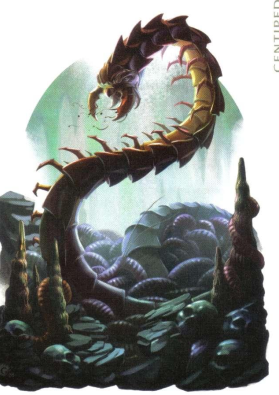Let's Read the 4e Monster Vault 2: Centipede

This article is part of a series! Click here to see the other entries.
Monstrous centipedes have been in the game since the beginning, and are based on real-world animals. Let’s see what 4e makes of them.
The Lore
I only recently realized D&D centipedes aren’t as fantastical as I always thought. There are thousands of real-world centipede species, and the ones I was familiar with were pretty small and generally not dangerous to people. However, some species can reach up to 30cm (a foot!) in length, and have a poisonous bite that might cause fever and chills in people. It’s possible for someone to be allergic to centipede venom, and in that case their bite can cause anaphylatic shock.
So the only fantastical thing about the D&D centipede in early editions of the game was the fact that its venom was always save-or-die. Its size was realistic, and so was its venom in later editions when it became less deadly. Of course, the game also had truly giant centipedes which were entirely fantastical, and this remains true here.
Centipedes can be found in woodlands, caves, and lots of other environments. They’re ferocious predators and aggressive enough to attack much larger creatures if they feel threatened. The larger specimens are of a scale large enough to see humanoids as potential prey, too.
Despite all this aggressiveness, it seems lots of sapient creatures are able to keep them as pets and guard animals. I suspect magic might be involved. Centipedes are particularly popular pets for Torog worshippers, who consider them sacred.
The Numbers
Centipedes are Natural Beasts of varying size. The game gives them Darkvision, though it might be more accurate to give them blindsight instead. The authors didn’t consider a single foot-long centipede to be a worthy threat, so we get stats for a swarm of them and for a giant specimen.
Centipede Swarm
This Medium swarm is a Level 2 Brute with 44 HP. It has ground and climb speeds of 6, with Spider Climb (which allows them to cling to ceilings). It has all standard swarm traits, taking half damage from melee and ranged attacks, and 10 extra damage from close and area attacks.
Its Swarm Attack aura (1) deals 3 automatic damage to each enemy caught inside, +2 per centipede swarm adjacent to the enemy. This is deceptively dangerous, particularly if you assume multiple swarm auras stack! An enemy adjacent to a single swarm will take 5 damage at the start of their turn. An enemy adjacent to 2 of them would take 14, or 7 if the auras don’t stack.
The swarm’s basic attack is a Swarm of Mandibles (vs. Reflex), which deals a little bit of physical damage, which increases by 1 with each adjacent centipede swarm. A hit also deals ongoing 5 poison damage (save ends). If the enemy is already taking ongoing poison damage, they’re weakened (save ends).
If the swarm is hit by an area or close attack, their Survival Instinct causes them to shift 3 squares as a reaction.
An interesting monster: despite being a brute, its attack is kinda weak. Most of the damage comes from the swarm aura, particularly if you assume multiple centipede swarm auras stack. You’ll never encounter just one swarm either - there should be at least two in the group to enjoy those cool exponential bonuses. More than two might be pushing a bit, though.
Centipede Scuttler
A proper giant, this is a single Medium individual. It’s a Level 4 Skirmisher with 51 HP and both ground and climb speeds of 8. Can’t run away from it.
Its bite targets AC and does a little more damage than the swarm’s, but has the same riders. Against a weakened creature (which likely got that way from its venom) it can Feed, dealing roughly triple the damage of a basic bite.
As an at-will move action, the Scuttler can, well, Scuttle, which allows it to shift 4 squares. When it shifts into an ally’s space while scuttling, that space doesn’t count as one of the 4 squares. Be sure to give it lots of buddies when building the encounter.
Sample Encounters and Final Impressions
We get two encounters:
-
Level 4: 1 ankheg, 2 bloodthorn vines, and 2 centipede swarms. What rotten luck that all of them would be hanging out next to each other.
-
Level 5: 2 scuttlers, 1 gnoll huntmaster, 2 gnoll marauders. So they keep more than hyenas as pets.
I liked the old save-or-die centipedes and these feel properly scary as well, while also being distinct from all the other giant creepy crawlies.